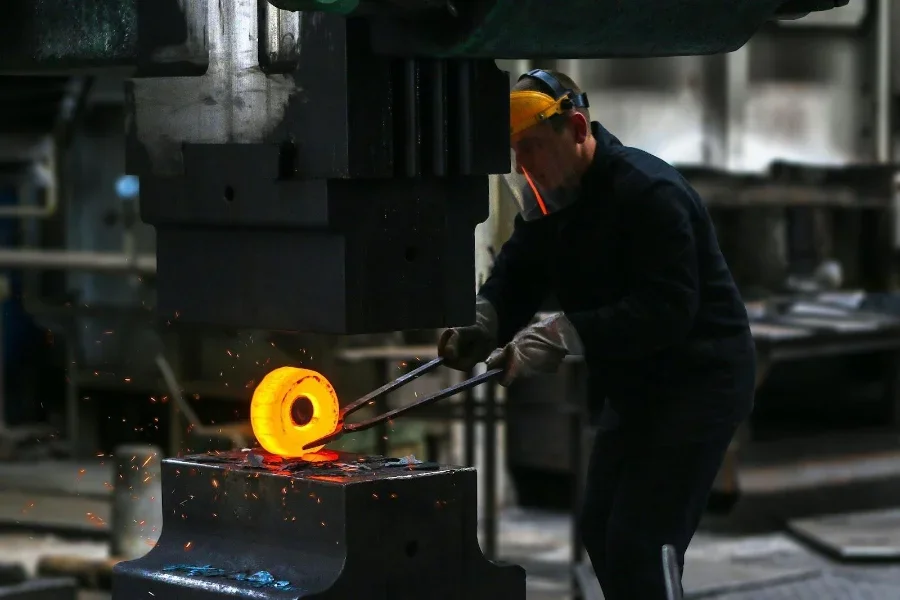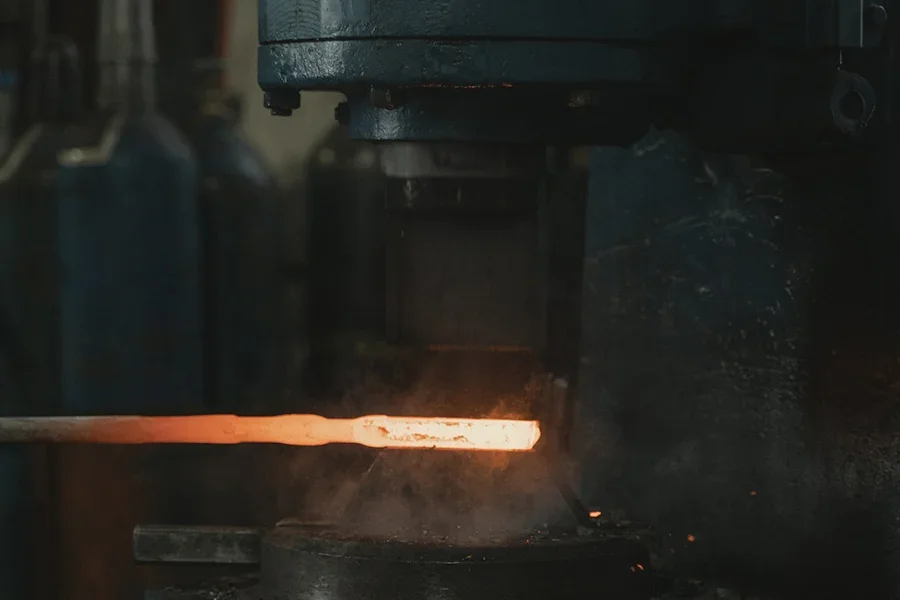Metal forging machines are staples in many industries as they’re at the forefront of all metal manufacturing processes. However, choosing these machines can be tricky if the proper considerations are unknown.
Hence, this article will highlight three factors for brands and businesses to note while choosing metal forging machines and four hot-selling types to leverage.
Table of Contents
How profitable is the metal forging market?
4 factors to consider before purchasing metal forging machines
4 hot-selling metal forging machines
Final words
How profitable is the metal forging market?
The global metal forging market reached a remarkable US $74.36 billion in 2021. Research suggests that the industry will grow at a compound annual growth rate (CAGR) of 7.7% from 2022 to 2030. The automotive industry has been one of the notable end-users of the market dominating with a revenue share of more than 58.5% in 2021.
In terms of raw materials, carbon steel holds over 43.5% of the global market revenue share, making it the highest stakeholder. Carbon steel is significantly cheaper compared to stainless steel, making it preferable in automotive and oilfield applications.
Volume-wise, experts predict aluminum will surpass other metals, as it is a paragon for places requiring critical safety. Its lightweight properties also make it ideal for speedy and efficient production.
In addition, Asia-Pacific continues to lead in the regional segment, accounting for more than 51.8% of the global market. The expanding need for metal forgings in the automobiles, energy, railways, and aerospace industries are factors driving this market’s potential.
4 factors to consider before purchasing metal forging machines
1. Understand the different forging techniques

Purchasing metal forging machines depends on different methods and processes, which consumers will use to shape and form metal. Several techniques work for forging metals, including open die, closed die, and hot and cold forging.
Open die forging uses two flat dies, allowing forgers to place metal pieces and strike with a hammer or press. Interestingly, this process can shape metal into larger and more complex shapes. In contrast, closed die-forging entails using a die cavity with a pre-shaped contour.
For this technique, metal workers will place their workpieces between the die and strike for more precise and elaborate shapes.
Cold forging involves forging metals while keeping them at room temperature. The technique is widespread for creating parts in the automotive and electronics industries. Also, blacksmiths can use the hot forging method to shape workpieces at high temperatures, which increases the metal’s ductility. Metal workers often use this procedure to create parts in aerospace and construction.
Additionally, roll forging utilizes a series of rolls to shape metals by applying pressure. It is appropriate for long, thin special parts used in aerospace and defense industries. Likewise, upset forging increases the cross-sectional area of a metal rod by continuous hammering between two dies.
2. Choose the preferred forging type

Factors such as metal properties, the scale of production, and the desired final product will influence consumers’ preferred forging type. For example, aluminum is lightweight and heat-treatable, making it a good choice for closed or open-die forging. Steel, on the other hand, is sturdy and requires heating. Thus, an optimal combination includes combining hot hammer forging with press or roll forging.
Techniques like roll forging and extrusion are most efficient for large-scale production. They’re faster than other techniques, allowing metal workers to produce more shaped metallic pieces. Conversely, hand forging or drop forging may also be appropriate for small-scale production.
Furthermore, the desired final product defines what forging techniques metal forgers will use. For instance, closed die forging is best for making objects that require high degrees of precision, while hammer or press forging is ideal for shaping metals that require maximum strength. Other considerable factors include the cost of equipment and the skill required.
3. Determine the target consumer’s requirements
Metal forging machines are functional in various industries, like automotive, construction, aerospace, electronics, medical, and architecture. Every industry has its requirements, which determine what metal forging materials consumers will demand.
Moreover, customers expect machines that are both cost-effective and high quality. Retailers must consider providing competitive prices while still maintaining industry standards.
4. Size and material of forging parts

Another factor determining the type of metal forgers to form is the forging parts’ size and materials. Generally, consumers may opt for industrial-sized metal forging machines when working with larger metal pieces that require mechanical strength.
However, smaller metal forging machines are ideal for DIY and less-prominent projects. They can also handle delicate shaping but may be tricky when working on larger complex shapes. Ideally, metal forging machines should feature durable materials that can withstand extremely high temperatures.
4 hot-selling metal forging machines
1. Hammers
Although most consumers think of hammers as tools used to drive and uproot nails, forging hammers have unique designs for shaping and forming metals through continuous strikes. Forging hammers often feature high-quality steel, which helps to withstand the high force and heat generated during metal working.
Forging hammers have different types, each with designs for a specific task. The blacksmith hammer is a well-known variant used for shaping and forming hot metal on an anvil. On the other hand, power hammers come with motors that help generate high-frequency hammering strokes.
Hammers are ideal for blacksmiths, metalworkers, and other professionals in the metal fabrication industry. Consumers can use it to produce tools, weapons, decorative objects, and many other items.
2. Presses
Mass production often requires metal forging machines capable of exerting a much higher force than hand hammers. One type that checks the list is the press. Interestingly, consumers often use presses for open and closed-die forging. These machines can also create intricate metal designs due to their high accuracy level.
The most popular example is the mechanical press. Metalworkers can use them for different operations, ranging from punching to drawing and blanking. Another functional type is impact presses. These use customized hammers attached to a piston to strike and shape metal.
One quirky variant is the hydro-forming press. This machine uses high-pressure fluid, like water, to shape metal.
3. Upsetters
Upsetters are specialized machines used for increasing metal diameter and reducing metal length. Interestingly, these machines use the upsetting process to create projects like shaft shoulders.
These metal working machines clamp workpieces via holding fixtures before striking with a punch (or ram) attached to a moving mechanism. The ram can also host various shapes, depending on the consumer’s preferred part shape.
Like presses, upsetters are ideal for mass production and crafting larger pieces, like gears, crankshafts, and other automotive components.
4. Ring rollers
Ring rollers are metal forging machines with one specific purpose: creating ring-shaped parts. Crafting things like rings and gears require special machinery, and these machines are up for the challenge.
Rollers use a rolling process that involves using cylindrical rollers to compress and achieve the desired metal shape. Ring rollers have varying designs that match the desired circular shape.
Ring rollers have two rollers helping to shape metal pieces — one stationary and the other movable. Alternatively, some ring rollers have three rollers, with two being motionless and one movable. Patrons of these metal forging machines are usually in the automotive, construction, or aerospace industries, as ring rollers can produce round parts with high precision and accuracy.
Final words
Metal forging machines are essential for any metalworking industry. Choosing the right one to offer can help boost sales to impressive levels.
Businesses can follow these considerations to understand what their target audience wants before purchasing metal forging machines. Alternatively, brands may include all types to provide more diverse product offerings.



